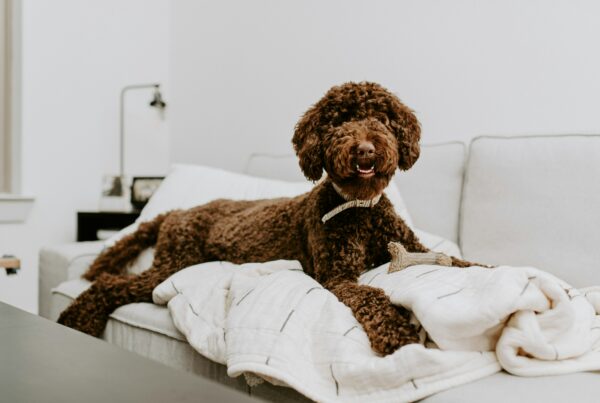From Pixabay
When scrambling to get your move in order, pet owners often unintentionally neglect their pet. Remember that relocating is stressful for everyone involved. Fido might not be apartment-hunting, sorting out paperwork, or packing boxes like you, but they are saying goodbye to their home, and that is never easy.
When you move to a new house or new town, your well-behaved dog may change overnight. It is a part of the process. Moving introduces so many stress-triggers for them. It’s best to learn how to handle them to keep your dog happy and healthy throughout the move!
Problem: Separation Anxiety
Separation anxiety happens when you or the other members of your family leave your dog. It triggers destructive tendencies that may include peeing and pooping indoors, whining and howling, chewing and digging, and trying to escape, among many others.
It can be a common occurrence when your dog came from a shelter. However, pets who stay with the same family can experience it as well. There is no concrete answer to why separation anxiety happens. Still, its triggers can be narrowed down to a new guardian, new residence, new schedule, or any other changes in dynamics in the home.
Solution: Provide Affirmation And Positive Reinforcement
The solution for separation anxiety is to maintain their routine. If you cannot create a workaround, look into getting an extra pair of hands to assist you. You can hire a pet-sitter to take care of feeding your dog on time and taking them out on regular walks and visits to the park. A pet-sitter can follow your instructions and firmly enforce their routine. By doing this, you are improving their feeling of security.
You can also hire a removals company for your moving day. With their help, you don’t have to dedicate long hours to packing, lifting, and transporting your belongings. A removals company helps you have a stress-free move and free up your day to care for your dog. When you move on your own, you may be physically present, but mentally and emotionally absent. Your dog can sense that. To ensure that your dog gets the attention they need, and your fragile items stay intact during the move, professional movers and packers are the way to go.
Essentially, the solution boils down to giving support, maintaining your dog’s routine, providing words of affirmation, and positive reinforcement in the form of a treat can help prevent and deal with bouts of separation anxiety.
Problem: Motion Sickness
As you drive to your new home, you might notice your dog whining, excessively drooling, restlessly pacing, vomiting, among other things. These are the tell-tale signs that they are suffering from motion sickness. It is never good to notice these symptoms mid-trip without having anything on hand, so preparation is key.
Some dogs may be more prone to motion sickness than others. Puppies, senior dogs, and those that don’t travel often may exhibit these symptoms. Try to identify whether your dog has issues with motion sickness or not to save yourself from cleaning puke later in the trip. Lining your car with towels is not enough. You need to be able to manage your dog’s nausea effectively.
Solution: Change Your Car’s Environment
The key factor you can improve is your car’s environment. Do not crowd your dog with bags and boxes. Those items go straight to your rented van. Instead, give them the whole back seat to lie down and relax. Then try to keep your car as well-ventilated as possible. You can achieve this by rolling down your windows or blasting the AC on high. When your dog is in place, make it a point to keep your drive as quiet as possible, or play soft music. You can keep your pop ballads and heavy bass for another time. For now, focus on your dog.
Give them a treat once and a while and take short breaks after every 1 hr 30 mins-2 hrs so they can stretch their legs. With your dog facing towards the front of the car/ dashboard, armed with their favorite comfort item, you can keep the motion sickness at bay.
Remember, they must stay in that position. You can either invest in a dog seat belt or multi-purpose harness. Or if your dog is crate-trained, you can keep them in their carrier while you are on the road. Besides helping them maintain the optimal position, it is an excellent way to keep them safe and secure during a trip.
Tip: Motion sickness doesn’t have to be a permanent issue. When you introduce your dog to the car and car rides early on, they can build up their tolerance and learn to enjoy them instead. When your dog continues to show symptoms of motion sickness, consult your vet for anti-nausea or anti-anxiety medicine.
Problem: Leaving The Home
The relocation problems don’t end after the long trip. Even after you are settled in your new flat, you may notice your dog trying to slip away. Dogs are territorial by nature, so it might take a while before they consider your new address as home. When your dog tries to leave, they are trying to go back to your old place.
Solution: Be Patient
The best thing you can do when your dog tries to make a run for it every time they see an opening is to be patient. Getting accustomed to a new environment always takes a bit of time, and there are no exceptions for dogs. You can try to curb these episodes by enforcing the idea of “home.”
You can take the time to set up their territory. Make sure your dog has a spot in the house with their bed and dog bowl. Give them a tour around the flat and the neighborhood and make it feel familiar. You can accomplish this by taking walks and having play sessions with other dogs. These memories are important in solidifying the idea that this is now home.
In the meantime, you can exercise precautionary methods like updating the information on their collar or chip and sealing off possible exits. If you have a garden, you may want to pay attention to the fence and side doors. Temporary blocks like garbage bins or pieces of wood won’t stand a chance against a determined dog. Proper repairs can be an excellent long-term investment to keep your dog in and your neighbor’s pets, out.
For other general moving advice, you can check out our moving tips with pets here.




